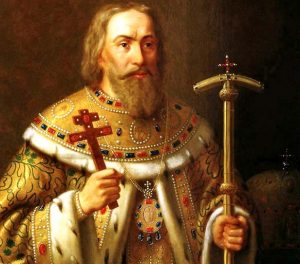(1606 – 1610)

He was enthroned by his adherents, and not by the great zemstvo Duma, Vasili Ivanovich Shuisky was not able to stay on the throne.
In Moscow, there were many dissatisfied with Shuisky. His adherents, with the help of which he reigned and who did not reward, reproached him for his stinginess. Many of the boyars themselves wanted to take the throne.
Without any support, Shuisky did not possess the abilities of a ruler and did not know how to act boldly and decisively. His whole reign was a complete turmoil.
Soon a new impostor, Falsdmitry II, who was known under the name of the Tushinsky thief (from the village of Tushin, 12 versts from Moscow, where his camp was located), came from Lithuania. But he failed to take possession of the Moscow throne. Detachments from Tushin scattered throughout the Moscow regions and robbed.
Poles under the command of Jan Sanega and Lisovsky besieged the Trinity-Sergius Lavra, which defended for 16 months.
Shuisky turned to the Swedes for help, sending Skopin his nephew for talks. King Swedish Charles IX willingly helped Shuisky. The Swedish detachment of 5 thousand people, under the command of General Delagardi, connected with Shuisky’s nephew Skopin.
They moved from Novgorod to Moscow, clearing of the Tushino gangs of the region lying on their way. After that, Skopin-Shuisky liberated the Trinity-Sergius Lavra.
Sigismund III, the King of Poland, declared war on Shuisk, besieged Smolensk and demanded that all Poles who served the impostor come to his aid.
Then the impostor, afraid that he would not be given to his enemies, secretly escaped from Tushin to Kaluga. After that, the entire Tushino camp disintegrated.
Moscow was freed from the Tushino thief (1610), and Skopin solemnly entered Moscow, enthusiastically greeted by the people, who hoped to see him king after the childless Shuisky. But soon at one feast he fell ill and died a few days later.
The death of Skopin, a talented military commander, was a heavy loss for the Russian land, which Sigismund was threatening, summoned to Moscow by traitors. Yes, and Tsar Vasily could rest on the throne only thanks to the victories of his nephew.
At that time, the army sent by Shuisky against Sigismund was severely defeated in the village of Klushin by Hetman Zholkeyevsky, who after this victory went to Moscow to elevate Vladislav to the throne of Moscow.
The pretender also moved from Kaluga to Moscow.
Then the Moscow boyars, led by Zakhar Lyapunov, deposed Shuisky and tonsured him into monks.
The interregnum began (1610-1613).
Before the election of the new tsar, the boyar Duma, which was called by the number of its members (7), was called the Semiboyar.
At this time, the Poles who took possession of Moscow, using out-of-the-way, countless gangs wandered around Russia, robbed and burned everything in their path.
Nearly all of the Russian land was empty, and they nicknamed this fierce time – hard times.
This continued until the rescuers of the Russian people, Minin and Pozharsky, came to the rescue, and until Mikhail Fyodorovich, the first tsar from the Romanovs’ house, sat on the throne of Moscow.